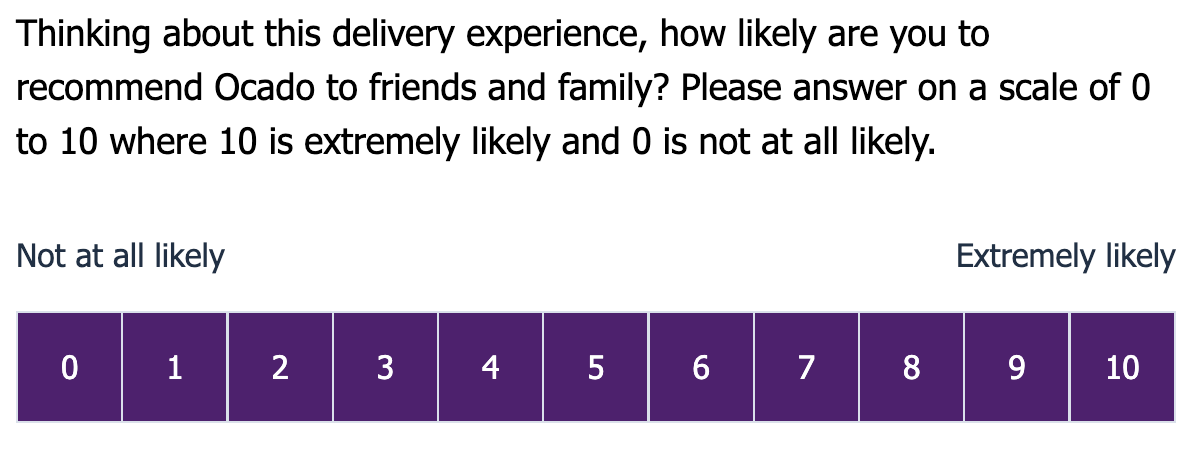Turning NPS into action: how to make the most out of a... dubious metric*
*Title co-written with OpenAI's ChatGPT
So you joined a new company and one of their key metrics is the NPS. Most UX-ers have no say over this but there are ways we can use NPS data to help us further understand our users, uncover their pain points, and discover opportunities to improve their experience.
The purpose of this post is to help you make the most out of the NPS, or at least ensure that it is measured properly, in your company. I’m not advocating for the NPS but this is a guide on how to use something far from perfect to learn more about the people who use your product/website/app and even recruit participants for your research!
What’s the NPS1?
Definition: The net promoter score (NPS) is a metric that quantifies how many more people are likely to strongly recommend your site or product compared to those likely to criticize it - Fessenden, 2016
The NPS stands for “Net Promoter Score” and is a measure of customer loyalty based on a single question: “How likely is it that you’ll recommend this product/website/service to a friend or colleague”? Participants can provide an answer on a scale from 0–10, where 0: Not at all likely and 10: Extremely likely.
This question is usually followed by an open text-box asking users to explain why they gave a specific score.
Responses can then be grouped into 3 categories:
Promoters: Responses from 9-10, which indicate high satisfaction and strong likelihood of recommendation
Passives: Responses from 7-8, which indicate moderate satisfaction, but low likelihood of recommendation
Detractors: Responses from 0 to 6, which indicate dissatisfaction and likely criticism
The NPS is calculated by subtracting the percentage of detractors from the percentage of promoters. For example, if we have 100 responses with 50 Promoters, 20 Passives, and 30 Detractors, we would have an NPS of 20%. This means that we have 20% more promoters than detractors.
You might have noticed that the Passives do not contribute to the score. This was a decision by the creators of the NPS as they felt that these users are passively satisfied with the product and do not actively promote the product or service with family or friends.
NPS can range from -100% (only detractors) to +100% (only promoters). A positive score indicates that the promoters outnumber detractors by the NPS%, while a negative score shows poor customer loyalty, with detractors outnumbering promoters.
What is a good NPS, you might wonder. It depends. A study by Sauro looked at 20 different software products and found that the NPS score ranged from -26% to 40%, with an average of 15%. In general, there are two ways to make sense of the NPS:
compare it to your NPS for the previous month/quarter/year
compare it to industry benchmarks. There are a few databases you can use to do this. This is a link

Is your company measuring NPS properly?
In my career I’ve seen numerous examples of poorly measured NPS. This is usually done by teams with no research background and lack of understanding of measurement biases. Consider the following:
Is the target audience clearly defined? The NPS should be administered to a representative sample of customers who have experience with the product or service. This will ensure that the data collected is relevant and accurate.
Are you using a consistent and standardised survey to collect data: The NPS survey should be administered in a consistent and standardised way to all customers. This will ensure that the data collected is comparable and can be accurately analysed.
How often and how is the data analysed? The NPS data should be analysed on a regular basis, ideally at least once per quarter. This allows us to track trends over time and identify areas for improvement.
How do users receive the NPS? What’s the strategy? Check for bias in the way the survey is distributed. Collecting NPS at different parts of the user journey versus at the end of transaction results in a different metric (i.e., transactional versus relational NPS). Transactional NPS is meant to assess the customer’s opinion on a certain business transaction and is time sensitive. Relational NPS is what most of us think when we think of the NPS and it is used to determine a customer's loyalty to a company/brand over time.
Is the sample size adequate? Always report margins of error. Try explaining to your team what this means and how it affects their reliance on the metric. You might need to adjust strategy to ensure you can collect enough data. I created a Margin of Error NPS calculator on Google Sheets that you can use it to calculate the MoE on your data (ideally, you want a margin of error no more than 5%) .
NPS criticisms
I won’t go into too much detail here as there are many informative articles covering this already. For example, you can check Jared Spool’s famous article on the topic, “Net Promoter Score Considered Harmful (and What UX Professionals Can Do About It)” .
Here are a few points to keep in mind when working with the NPS:
Companies overuse the NPS. It’s everywhere and in many contexts it makes no sense. People don’t go out recommending random products and services to friends/family/co-workers.
Cultural factors affect scores and could cause issues if you are using the NPS to compare customer loyalty in different countries.
The NPS is not sensitive enough to smaller changes within the product/website/service. The strange scoring of the NPS, which totally ignores the ratings from Passives) and the reduction of scores from an 11-point scale to just three categories (Detractors, Passives, Promoters) results in a loss of statistical power and precision. This means that it’s hard to make it actionable.
How to make the most out of a not so useful metric
So we’ve established that the NPS has limitations and it’s probably not the most important metric you should be using. However, that doesn’t mean that it’s completely useless.
That open-ended question at the end of the NPS is the most useful thing for the UX team. By asking people why they give a specific score, you get a chance to uncover any pain points they have and discover opportunities to improve their experience. Granted, the issues reported might not be always linked to UX but you can ensure those are reported to the appropriate teams and further investigated. We’re all in this together, after all — UX is just one piece of the puzzle.
Use the NPS to give users a chance to give feedback. If you’re doing continuous research, use this as an opportunity to recruit participants. In the company I work for we use the quarterly NPS to recruit users for our continuous discovery interviews by giving them a chance to have follow-up interviews with the team to discuss their feedback. This ensures we better understand what problems they’re having.
Go beyond the metric. You need a follow-up process and that’s not only for the researchers. The NPS is a company-wide metric — everyone should be involved and accountable for it.
Complement it with other metrics. This is crucial for all metrics. You can’t rely your strategy on a single one even if it’s the best metric known to humanity. We’re going back to triangulation but this is key. Include more metrics at different parts of the user journey.
Use it strategically. A low NPS can give you an opportunity to conduct more research to understand the reasons behind it.
"NPS is just one piece of the puzzle and should not be used as the sole indicator of customer satisfaction and loyalty." - Don Peppers and Martha Rogers, authors of The One to One Future
Can you think of any other ways you can use the NPS to generate useful user insights?
NPS is trademark of Satmetrix Systems, Inc., Bain & Company, and Fred Reichheld.




